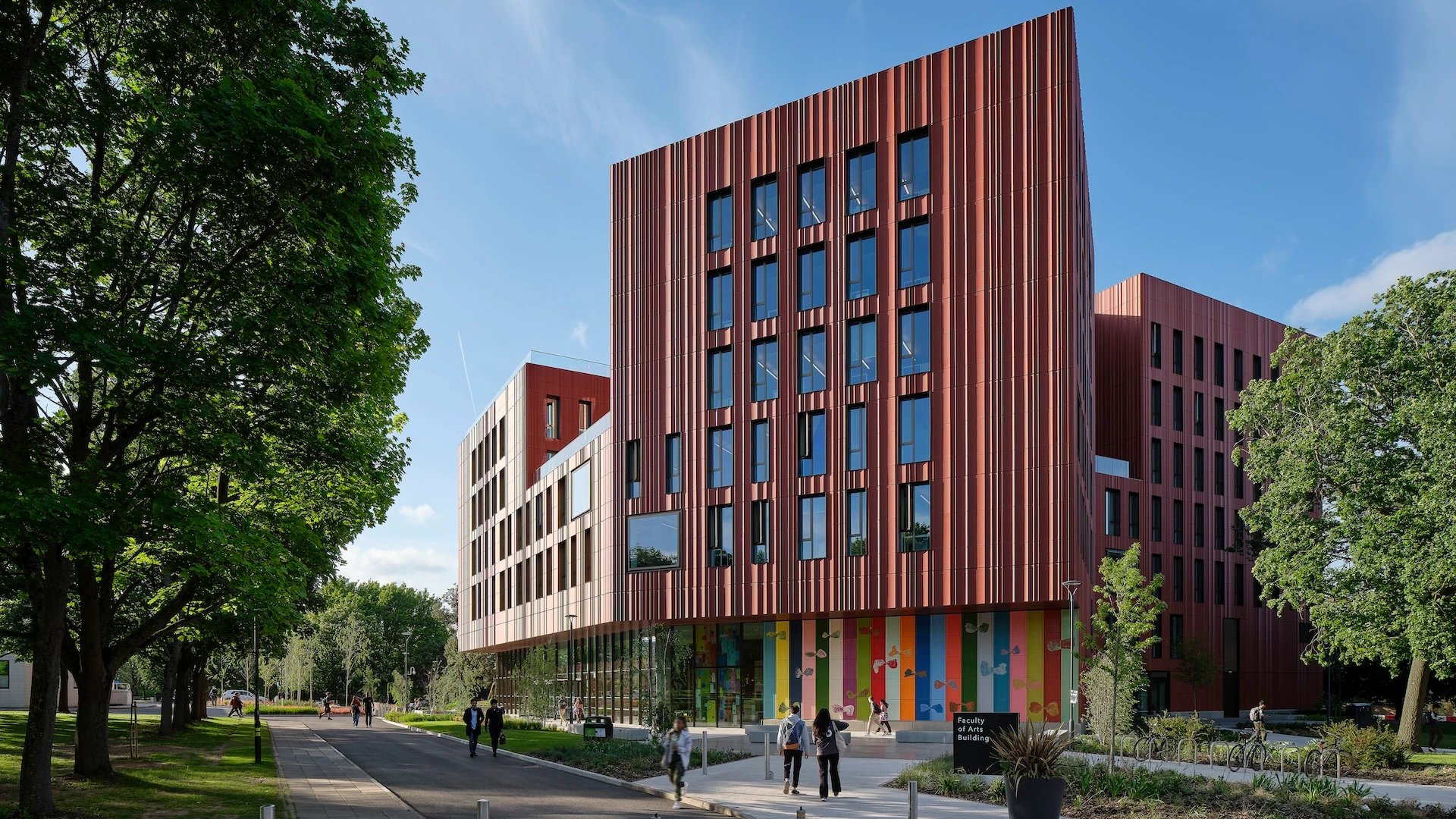& Construction

Integrated BIM tools, including Revit, AutoCAD, and Civil 3D
& Manufacturing

Professional CAD/CAM tools built on Inventor and AutoCAD
When Swedish biotech and green construction materials firm Ecohelix set out to build a new factory, it wanted to minimize environmental impact in line with its sustainability mission. The company specializes in wood-based components, and given that the new building would be located in a forest, the company wanted its carbon footprint to be negligible.
In the numbers-focused architecture, engineering, and construction (AEC) industry, carbon outcomes need to be quantified. Ecohelix wanted to know from the start what the new facility’s true carbon footprint would be. “We produce a wood-based product that has a positive impact on the total carbon footprint of a particular building’s value chain,” says Oskar Schmidt, Ecohelix’s chief technology officer. “When it comes to our full-scale plant, we want the most sustainable building materials that are practically and economically feasible.”
Ecohelix approached architects at Sweco, one of Europe’s largest architecture and engineering consultancies, to add carbon cost projections to its initial designs with Sweco’s in-house solution, Carbon Cost Compass, or C3. C3 is part of an emerging category of software tools that help architects and engineers simplify the laborious process of balancing trade-offs between a structure’s carbon footprint and costs while many design and materials options are still on the table.
Most carbon calculators focus on the embodied carbon in specific building materials or project the operating cost of a structure after its doors open. A few can go deeper to consider the impact of supply-chain choices and the building’s end-of-life plan.
AEC is one of the worst offenders when it comes to greenhouse gas emissions. A recent United Nations report found that the sector’s energy consumption and carbon-dioxide emissions had reached a new all-time high in 2021, accounting for 37% of global energy and process-related CO2 emissions. That’s 2% above the previous peak recorded in 2019.
With 230 billion square meters (PDF, p. 4) of new buildings planned by 2060, emissions associated with the industry’s embodied carbon consumption will keep rising if something doesn’t change. Carbon calculators could impact the way buildings are constructed by equipping designers with the data and insights they need to inform strategic choices around carbon and cost impacts from the earliest stages of site layouts to operations.
In the past, this calculation took place mainly on spreadsheets after a lot of data capture. After detailed calculations were made, arriving at the final projection took up time and resources. Depending on the design stage and the availability of details about building geometry and materials, it could take even longer. If any changes were made, the numbers had to be run again.
With the right software, that process can be reduced to a few clicks. In minutes rather than days, architects and engineers can see how different designs—and any subsequent changes—impact a project’s sustainability.
The best carbon calculators take granular data related to carbon impact and ensure that it sticks to an architect’s design model from the earliest stages. Users can visualize the impacts of design changes on carbon and cost in real time and make informed decisions that balance sustainability and business outcomes.
The use cases for each carbon calculator tend to correlate to specific stages in the building lifecycle. Here are a few options that give a snapshot of what’s currently available. The following solutions work seamlessly with building information modeling (BIM) data. To find more embodied carbon calculation tools, the nonprofit Carbon Leadership Forum (CLF) offers this handy resource.
When initial sketches are underway and the final geometry of a structure is being completed, the EPIC tool from EHDD architects can calculate projected embodied carbon costs. When information about materials and dimensions is limited, EPIC uses the c.scale carbon calculation methodology to take an initial design and draw on industry data to come up with approximate carbon emissions. Sweco’s C3 is also effective in the early concept phase. With C3, it is possible to compare different solutions and quickly find the best climate and budget options. It’s already being used by Ecohelix and others to calculate carbon emissions and construction costs.
Later in the process, when there is enough detail about building geometry and materials to generate a complete BIM model, Sweco’s C3, tallyCAT (see below), and Autodesk Insight: Carbon Insights are useful tools. Carbon Insights (currently a Tech Preview) can be used to perform “cradle-to-gate” analyses of exterior building walls and windows directly within Autodesk Revit. It offers useful insights into the carbon impact of different materials from raw material extraction through the manufacturing process.
The Embodied Carbon in Construction Calculator (EC3) is a free tool from Building Transparency. Now being integrated with another free option called the Tally Climate Action Tool, or tallyCAT, the combined platform lets architects, engineers, and clients perform a deep analysis of the embodied and operational carbon costs for a completed building design. It can also provide a calculation of carbon cost embedded in the supply chain for the building’s selected materials.
The One Click LCA calculator enables architects to go even further and calculate the upstream impacts of their designs. It covers the full projected lifecycle of a building—including its eventual demolition and disposal—and helps architects conduct accurate analysis to optimize the design process and meet certification criteria for low‐carbon building solutions.
To help design a sustainable, collaborative space for the Faculty of Arts Building (FAB) at the University of Warwick in Coventry, England, Feilden Clegg Bradley Studios (FCBStudios) turned to its free whole-life carbon review tool, FCBS Carbon.
FCBStudios took data from Autodesk Revit 3D models, plugged it into FCBS Carbon, and assessed the embodied carbon impact of, for example, changing the façade material. Originally, the heavily fluted terracotta façade effect on the exterior of the building was to be created using five extruded terracotta tiles. However, the design team used Revit to model the effect of changing the number of tiles from five to just two, which helped save on material costs. The cladding was also switched from glazed terracotta to unglazed, leading to a 35% saving on embodied carbon.
But FAB isn’t only fabulous aesthetically—the project’s sustainability credentials were part of what endeared the building to the judging panel of the RIBA Stirling Prize 2023, where it was nominated for the prestigious award and took home the RIBA West Midlands Building of the Year Award.
When US flooring company Interface conceived of its new headquarters in downtown Atlanta, initial plans called for a 70,000-square-foot building. After analyzing its design using EC3 (PDF, p. 8), the firm's architects realized they could achieve the same objectives with a 40,000-square-foot building.
By implementing flexible seating and “hot desking,” the overall use of space dramatically improved. Architects then analyzed two options using EC3: a 40,000-square-foot new build versus a renovation of a 1960s-era 40,000-square-foot building in the city center.
Interface chose the second option and found that renovating and reusing bricks from the existing building would reduce embodied carbon by 50.48% (PDF, p. 9), while also reducing the overall impact of the building (including parking) by 42%.
Although accurately measuring sustainability has been on the AEC agenda for years, its complexity, competing models, and disagreement over standards all contributed to a lack of transparency in carbon-accounting tools and practices. As carbon cost calculators improve and mature, the hope is that architects and clients can modernize processes and achieve accurate, impactful results.
"There is a very strong synergy between carbon costs and the hard costs of different construction materials in the initial stages of a project,” says Mathias Näll, digital development lead at Sweco. “The decisions you make about sustainability and materials will give you greater control—if you make them early on.”
Mark de Wolf is a freelance journalist and award-winning copywriter specializing in technology stories. Born in Toronto. Made in London. Based in Zürich. Reach him at markdewolf.com.
AECO
AECO
Executive insights








